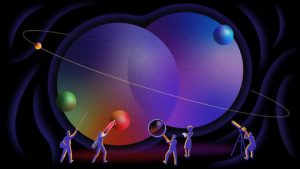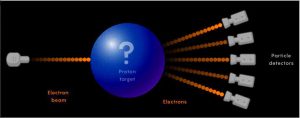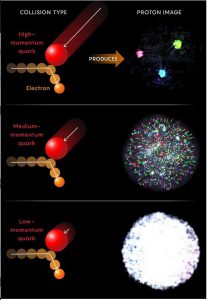Inside the proton, the ‘most complicated element’ you could imagine
Researchers recently discovered that the proton sometimes includes a charm quark and charm antiquark, colossal particles that are each heavier than the proton itself.
“The positively charged particle at the heart of the atom is an object of unspeakable complexity, one that changes its appearance depending on how it is probed. We’ve attempted to connect the proton’s many faces to form the most complete picture yet,” researchers said.

More than a century after Ernest Rutherford discovered the positively charged particle at the heart of every atom, physicists are still struggling to fully understand the proton.
High school physics teachers describe them as featureless balls with one unit each of positive electric charge — the perfect foils for the negatively charged electrons that buzz around them. College students learn that the ball is actually a bundle of three elementary particles called quarks. But decades of research have revealed a deeper truth, one that’s too amazing to fully capture with words or images.
“This is the most complicated element that you could possibly imagine,” said Mike Williams, a physicist at the Massachusetts Institute of Technology. “In fact, you can’t even imagine how complicated it is.”
The proton is a quantum mechanical object that exists as a haze of probabilities until an experiment forces it to take a concrete form. And its forms differ drastically depending on how researchers set up their experiment. Connecting the particle’s many faces has been the work of generations. “We’re kind of just starting to understand this system in a complete way,” said Richard Milner, a nuclear physicist at MIT.
As the pursuit continues, the proton’s secrets keep tumbling out. Most recently, a monumental data analysis published in August 2022 found that the proton contains traces of particles called charm quarks that are heavier than the proton itself.
The proton “has been humbling to humans,” Williams said. “Every time you think you kind of have a handle on it, it throws you some curveballs.”
Recently, Milner, together with Rolf Ent at Jefferson Lab, MIT filmmakers Chris Boebel and Joe McMaster, and animator James LaPlante, set out to transform a set of arcane plots that compile the results of hundreds of experiments into a series of animations of the shape-shifting proton.
Cracking Open the Proton
Proof that the proton contains multitudes came from the Stanford Linear Accelerator Center (SLAC) in 1967. In earlier experiments, researchers had pelted it with electrons and watched them ricochet off like billiard balls. But SLAC could hurl electrons more forcefully, and researchers saw that they bounced back differently. The electrons were hitting the proton hard enough to shatter it — a process called deep inelastic scattering — and were rebounding from point-like shards of the proton called quarks. “That was the first evidence that quarks actually exist,” said Xiaochao Zheng, a physicist at the University of Virginia.
After SLAC’s discovery, which won the Nobel Prize in Physics in 1990, scrutiny of the proton intensified. Physicists have carried out hundreds of scattering experiments to date. They infer various aspects of the object’s interior by adjusting how forcefully they bombard it and by choosing which scattered particles they collect in the aftermath.

By using higher-energy electrons, physicists can ferret out finer features of the target proton. In this way, the electron energy sets the maximum resolving power of a deep inelastic scattering experiment. More powerful particle colliders offer a sharper view of the proton.
Higher-energy colliders also produce a wider array of collision outcomes, letting researchers choose different subsets of the outgoing electrons to analyze. This flexibility has proved key to understanding quarks, which careen about inside the proton with different amounts of momentum.
By measuring the energy and trajectory of each scattered electron, researchers can tell if it has glanced off a quark carrying a large chunk of the proton’s total momentum or just a smidgen. Through repeated collisions, they can take something like a census — determining whether the proton’s momentum is mostly bound up in a few quarks, or distributed over many.

Even SLAC’s proton-splitting collisions were gentle by today’s standards. In those scattering events, electrons often shot out in ways suggesting that they had crashed into quarks carrying a third of the proton’s total momentum. The finding matched a theory from Murray Gell-Mann and George Zweig, who in 1964 posited that a proton consists of three quarks.
Gell-Mann and Zweig’s “quark model” remains an elegant way to imagine the proton. It has two “up” quarks with electric charges of +2/3 each and one “down” quark with a charge of −1/3, for a total proton charge of +1.
Three quarks careen about in this data-driven animation
But the quark model is an oversimplification that has serious shortcomings.
It fails, for instance, when it comes to a proton’s spin, a quantum property analogous to angular momentum. The proton has half a unit of spin, as do each of its up and down quarks. Physicists initially supposed that — in a calculation echoing the simple charge arithmetic — the half-units of the two up quarks minus that of the down quark must equal half a unit for the proton as a whole. But in 1988, the European Muon Collaboration reported that the quark spins add up to far less than one-half. Similarly, the masses of two up quarks and one down quark only comprise about 1% of the proton’s total mass. These deficits drove home a point physicists were already coming to appreciate: The proton is much more than three quarks.
Much More Than Three Quarks
The Hadron-Electron Ring Accelerator (HERA), which operated in Hamburg, Germany, from 1992 to 2007, slammed electrons into protons roughly a thousand times more forcefully than SLAC had. In HERA experiments, physicists could select electrons that had bounced off of extremely low-momentum quarks, including ones carrying as little as 0.005% of the proton’s total momentum. And detect them they did: HERA’s electrons rebounded from a maelstrom of low-momentum quarks and their antimatter counterparts, antiquarks.
Many quarks and antiquarks seethe in a roiling particle “sea”
The results confirmed a sophisticated and outlandish theory that had by then replaced Gell-Mann and Zweig’s quark model. Developed in the 1970s, it was a quantum theory of the “strong force” that acts between quarks. The theory describes quarks as being roped together by force-carrying particles called gluons. Each quark and each gluon has one of three types of “color” charge, labeled red, green and blue; these color-charged particles naturally tug on each other and form a group — such as a proton — whose colors add up to a neutral white. The colorful theory became known as quantum chromodynamics, or QCD.
According to QCD, gluons can pick up momentary spikes of energy. With this energy, a gluon splits into a quark and an antiquark — each carrying just a tiny bit of momentum — before the pair annihilates and disappears. It’s this “sea” of transient gluons, quarks and antiquarks that HERA, with its greater sensitivity to lower-momentum particles, detected firsthand.
HERA also picked up hints of what the proton would look like in more powerful colliders. As physicists adjusted HERA to look for lower-momentum quarks, these quarks — which come from gluons — showed up in greater and greater numbers. The results suggested that in even higher-energy collisions, the proton would appear as a cloud made up almost entirely of gluons.
Gluons abound in a cloud-like form
The gluon dandelion is exactly what QCD predicts. “The HERA data are direct experimental proof that QCD describes nature,” Milner said.
But the young theory’s victory came with a bitter pill: While QCD beautifully described the dance of short-lived quarks and gluons revealed by HERA’s extreme collisions, the theory is useless for understanding the three long-lasting quarks seen in SLAC’s gentle bombardment.
QCD’s predictions are easy to understand only when the strong force is relatively weak. And the strong force weakens only when quarks are extremely close together, as they are in short-lived quark-antiquark pairs. Frank Wilczek, David Gross and David Politzer identified this defining feature of QCD in 1973, winning the Nobel Prize for it 31 years later.
But for gentler collisions like SLAC’s, where the proton acts like three quarks that mutually keep their distance, these quarks pull on each other strongly enough that QCD calculations become impossible. Thus, the task of further demystifying the three-quark view of the proton has fallen largely to experimentalists. (Researchers who run “digital experiments,” in which QCD predictions are simulated on supercomputers, have also made key contributions.) And it’s in this low-resolution picture that physicists keep finding surprises.
A Charming New View
Recently, a team led by Juan Rojo of the National Institute for Subatomic Physics in the Netherlands and VU University Amsterdam analyzed more than 5,000 proton snapshots taken over the last 50 years, using machine learning to infer the motions of quarks and gluons inside the proton in a way that sidesteps theoretical guesswork.
The new scrutiny picked up a background blur in the images that had escaped past researchers. In relatively soft collisions just barely breaking the proton open, most of the momentum was locked up in the usual three quarks: two ups and a down. But a small amount of momentum appeared to come from a “charm” quark and charm antiquark — colossal elementary particles that each outweigh the entire proton by more than one-third.
The proton sometimes acts like a “molecule” of five quarks
Short-lived charms frequently show up in the “quark sea” view of the proton (gluons can split into any of six different quark types if they have enough energy). But the results from Rojo and colleagues suggest that the charms have a more permanent presence, making them detectable in gentler collisions. In these collisions, the proton appears as a quantum mixture, or superposition, of multiple states: An electron usually encounters the three lightweight quarks. But it will occasionally encounter a rarer “molecule” of five quarks, such as an up, down and charm quark grouped on one side and an up quark and charm antiquark on the other.
Such subtle details about the proton’s makeup could prove consequential. At the Large Hadron Collider, physicists search for new elementary particles by bashing high-speed protons together and seeing what pops out; to understand the results, researchers need to know what’s in a proton to begin with. The occasional apparition of giant charm quarks would throw off the odds of making more exotic particles.
And when protons called cosmic rays hurtle here from outer space and slam into protons in Earth’s atmosphere, charm quarks popping up at the right moments would shower Earth with extra-energetic neutrinos, researchers calculated in 2021. These could confound observers searching for high-energy neutrinos coming from across the cosmos.
Rojo’s collaboration plans to continue exploring the proton by searching for an imbalance between charm quarks and antiquarks. And heavier constituents, such as the top quark, could make even rarer and harder-to-detect appearances.
Next-generation experiments will seek still more unknown features. Physicists at Brookhaven National Laboratory hope to fire up the Electron-Ion Collider in the 2030s and pick up where HERA left off, taking higher-resolution snapshots that will enable the first 3D reconstructions of the proton. The EIC will also use spinning electrons to create detailed maps of the spins of the internal quarks and gluons, just as SLAC and HERA mapped out their momentums. This should help researchers to finally pin down the origin of the proton’s spin, and to address other fundamental questions about the baffling particle that makes up most of our everyday world.
yogaesoteric
March 5, 2023
Also available in:
 Français
Français
